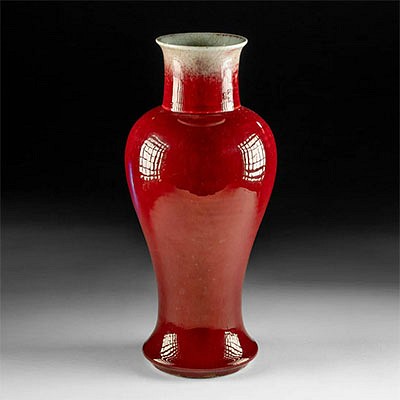1523 German Vellum Page, Livy's "Ab Urbe Condita"
Lot 311
About Seller
Artemis Fine Arts
686 S Taylor Ave, Ste 106
Louisville, CO 80027
United States
Selling antiquities, ancient and ethnographic art online since 1993, Artemis Gallery specializes in Classical Antiquities (Egyptian, Greek, Roman, Near Eastern), Asian, Pre-Columbian, African / Tribal / Oceanographic art. Our extensive inventory includes pottery, stone, metal, wood, glass and textil...Read more
Estimate:
$1,400 - $2,100
Absentee vs Live bid
Two ways to bid:
- Leave a max absentee bid and the platform will bid on your behalf up to your maximum bid during the live auction.
- Bid live during the auction and your bids will be submitted real-time to the auctioneer.
Bid Increments
| Price | Bid Increment |
|---|---|
| $0 | $25 |
| $300 | $50 |
| $1,000 | $100 |
| $2,000 | $250 |
| $5,000 | $500 |
| $10,000 | $1,000 |
| $20,000 | $2,500 |
| $50,000 | $5,000 |
| $100,000 | $10,000 |
| $200,000 | $20,000 |
About Auction
By Artemis Fine Arts
May 11, 2023
Set Reminder
2023-05-11 10:00:00
2023-05-11 10:00:00
America/New_York
Bidsquare
Bidsquare : Fine Antiquities, Asian, Pre-Columbian, Ethnographic Art
https://www.bidsquare.com/auctions/artemis-gallery/fine-antiquities-asian-pre-columbian-ethnographic-art-12771
Classical antiquities, ancient and ethnographic art from cultures encompassing the globe. Artemis Fine Arts info@artemisfinearts.com
Classical antiquities, ancient and ethnographic art from cultures encompassing the globe. Artemis Fine Arts info@artemisfinearts.com
- Lot Description
**First Time At Auction**
Northern Europe, Germany, Mainz, Renaissance period, ca. 1523 CE. A rare example from the early age of printmaking, straight from Mainz - the hometown of Guttenberg himself! A fascinating vellum page with illustrated woodblock prints from the first printing of a revised and enlarged German translation of Livy's "Ab urbe condita" (English: "From the Founding of the City") entitled "Romische historien Titi liuii mit etlichen newen Translation so kurtzuerschienen jaren im hohen thum Styfft zu Mentz jm latein erfunden und vorhyn nit mer gesehen sein [a free paraphrase by Bernard Schofferlin, continued by Ivo Wittich, with additions by Nikolaus Fabri Carbach]" published in 1523 by Johann Schoeffer, son of Peter Schoeffer the principal workman of Gutenberg. The book featured large and highly acclaimed woodblock illustrations cut by Conrad Faber von Creuznach combined with blocks cut for the editions published by Johann Schoffer in 1505 and by Johann Gruninger in 1507. Size of page: 12" L x 8.25" W (30.5 cm x 21 cm); of frame: 17.5" L x 14.4" W (44.4 cm x 36.6 cm)
Nikolaus Fabri von Carbach (German 1485-1534), the book's editor, was a lecturer in ancient history at the University of Mainz , who discovered in the library of Mainz cathedral a manuscript of Livy's "Ab Urbe Condita" containing Books 33-40, including 2 sections which had been missing so far. "Ab urbe condita" is a monumental history of ancient Rome written in Latin between 27 and 9 BCE by the Roman historian Titus Livius or Livy. It covers the period from the arrival of Aeneas and the refugees from the fall of Troy to the city's founding in 1753 BCE , the expulsion of the Kings in 509 BCE, and down to Livy's own time during the reign of the emperor Augustus.
This is page 9 from Carbach's 1523 version and contains text on one side and woodblock prints on the other. The text details events from the 7th century BCE when the Romans fought both the city of Alba Longa and the Etruscan cities of Veii and Fidenae. The images depict the battle of the Etruscan cities of Veii and Fidenae with the Romans and Albans, during which the recently-conquered Albans and their leader Mettius Fufetius were ordered by Roman leader Tullus Hostilius to join the Romans in battle. After they met the Etruscans on the far side of the Anio on the banks of the Tiber, however, Mettius led his troops away from the battle to watch the battle from a nearby hilltop, waiting to see which force would be victorious and planning join the leading side. Though the Romans were left to battle the Etruscans alone, they were still victorious and when Mettius congratulated Hostilius after the battle, Hostilius declared that since Mettius was torn between the 2 cities, the same would be done to his body. His arms were then attached to 2 chariots that then ran in opposite directions; the result was naturally fatal. Hostilius then had Alba Longa demolished and its people moved to Rome, as a warning to all future allies and subjects of Rome not to betray her. The central image portrays the punishment of Mettius while the top shows the Romans and Albans meeting on the banks of the Tiber and bottom displays the Albans retreating, returning, and Mettius and Hostilius speaking after the battle.
Provenance: ex-Stein collection, Bloomfield Hills, Michigan, USA, acquired prior to 2010
All items legal to buy/sell under U.S. Statute covering cultural patrimony Code 2600, CHAPTER 14, and are guaranteed to be as described or your money back.
A Certificate of Authenticity will accompany all winning bids.
We ship worldwide and handle all shipping in-house for your convenience.
#164005Page from a larger book. Some light tattering to edges of page with s few minor tears and 2 small perforations to middle. Light foxing and stains to page, as commensurate with age, but imagery and text are still very clear. Nice preservation of ink and detail. Set in a modern custom matte and wooden frame with suspension hooks on verso for display.Condition
- Shipping Info
-
All shipping is handled in-house for your convenience. Your invoice from Artemis Gallery will include shipping calculation instructions. If in doubt, please inquire BEFORE bidding for estimated shipping costs for individual items. In most cases Artemis Gallery cannot ship to Australia and Germany, please inquire before bidding.
-
- Buyer's Premium



 EUR
EUR CAD
CAD AUD
AUD GBP
GBP MXN
MXN HKD
HKD CNY
CNY MYR
MYR SEK
SEK SGD
SGD CHF
CHF THB
THB













